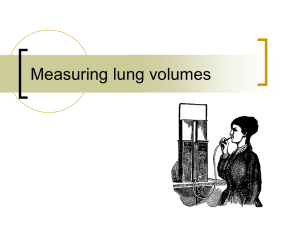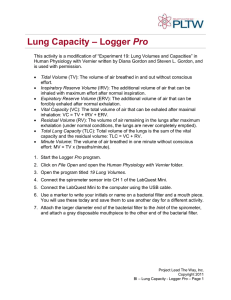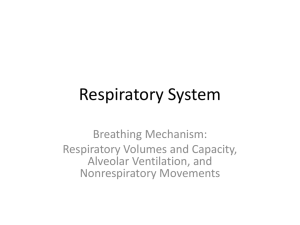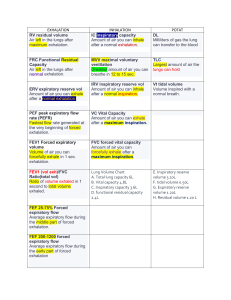Provide anatomy and physiology advice to clients
advertisement
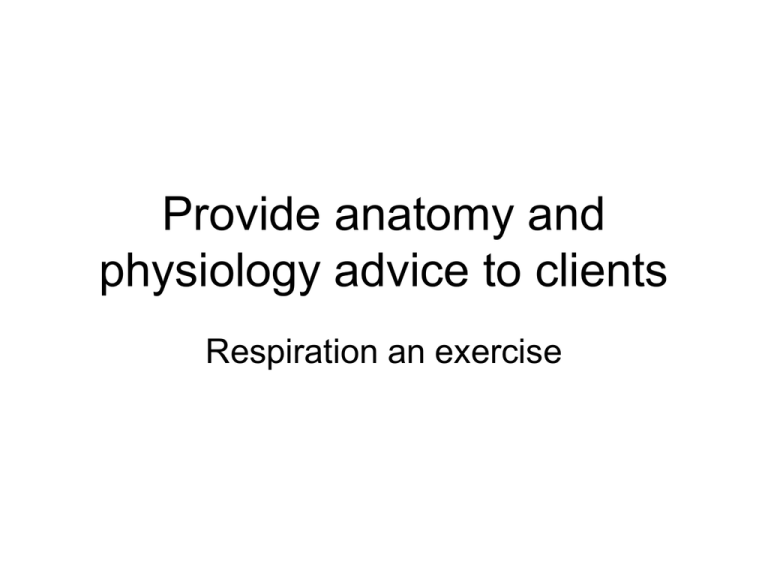
Provide anatomy and physiology advice to clients Respiration an exercise Respiration and exercise • The amount of oxygen that we use is regulated by the metabolic rate of our cells. It has been calculated that whilst we are at rest we use about 250ml of oxygen each minute. However, when we exercise our oxygen need can increase ten times (say 2500 ml per minute) and in high intensity exercise the increase may be perhaps as much as 20 times. When we exercise we engage more muscle cells in work and the oxygen demand to drive ATP synthesis in these cells obviously increases. Respiratory physiological changes with exercise • We have seen how training can increase cardiac output through strengthening the ventricular wall muscles and therefore increasing the stroke volume. Long term exercise can also increase the amount of oxygen inspired, by strengthening the diaphragm and intercostal muscles which in turn allow for more lung expansion. Both of these effects when combined increase the difference in oxygen pressure between the lungs and the lung capillaries which in turn permits more oxygen to enter the capillaries. Oxygen supply is the limiting factor in the amount of work that our muscles can do, so it is important that if person wants to increase the capacity of their muscles to work, then they need to increase the amount of oxygen that can be supplied. Mitochondrial changes • When we train our body can recognise the need for more oxygen so in response it manufactures more mitochondria in muscle cells. But the capacity of the heart to increase its stroke volume is limited, although the number of red blood cells can increase with training. The net result of this is that it is the lung that regulates our ultimate capacity to do work, and if the lungs are not functioning optimally, then our capacity to work harder in exercise is limited. An understanding of lung capacities is therefore important for those interested in fitness instruction. The notion of respiratory volume • The amount of air that we breathe obviously varies between people but also varies according to the conditions prevailing for a person at any time. It is useful for a fitness instructor to know about these volumes and some of the changes that might be expected during an exercise regime. The tidal volume • This is the amount of air that moves in and out of the lungs with each breath. It ranges between 500ml and 1000 ml across the population. The tidal volume can increase with exercise as the capacity of the lungs increases with exercise training. All the lung capacities may be measured by a spirometer. Inspiratory Reserve Volume • The amount of air that can be inspired forcibly beyond the tidal volume is called the Inspiratory Reserve Volume. This ranges from about 2000 to 3000ml across the population. Expiratory Reserve Volume • The Expiratory Reserve Volume is the amount of air that can be evacuated from the lungs after a tidal expiration. So, if you breathe out normally then evacuate the lungs, this is the Expiratory Reserve Volume. It is normally about 1200ml. Residual Volume • Even after you blow out all the expiratory reserve volume the lungs still have air in them. This is called the Residual Volume and is about 1200ml. The job of residual air is to keep the alveoli open and this prevents lung collapse. Respiratory Capacities • These consist of two or more lung volumes: the Inspiratory Capacity, the Functional Residual Capacity, the Vital Capacity and the Total Lung Capacity. Inspiratory Capacity • This is the total amount of air that can be inspired after a tidal expiration, so it is equal to the Tidal Volume plus the Inspiratory Reserve Volume. Functional Residual Capacity • The Functional Residual Capacity in the sum of the Residual Volume and the Expiratory Reserve Volume. Vital Capacity • The Vital Capacity of the lungs is the total amount of exchangeable air. This is the sum of the Tidal Volume, Inspiratory Reserve Volume and Expiratory Reserve Volumes. Total Lung Capacity • Total Lung Capacity is the sum of all volumes and is about 6 litres in healthy people. A table giving all these volumes and capacities is on this slide. Exercise and Pulmonary Changes • Whilst we are relaxed we breath about 12 times a minute and the tidal breath is about 500ml so that equates to 6000ml of air per minute. Now as we start to exercise our breaths become more frequent, even up to 50 per minute and they become deeper. In fact, the frequency of our breathing increases before we actually start to exercise. Our inspiratory centre controls our breathing rate in exercise and this in turn is controlled by the amount of lactate and other metabolic by products. But as we’ve seen earlier, the major respiratory changes due to exercise arise from increases in our tidal volume and the amount of oxygen that can diffuse from the lungs into the capillaries. Oxygen debt • Muscles have glycogen stores that allow them to contract for up to several hours and after that they can call on fat supplies to provide ATP. Now during anaerobic contraction oxygen is not required, but an oxygen debt results because oxygen still must be used to deal with the by products of anaerobic metabolism. So if you run 100 metres very quickly then you will need oxygen when you’ve finished. The high levels of lactic acid in your blood trigger the respiratory centre of your brain to make you breathe very deeply and gulp air. As you train and become fitter your oxygen carrying capacity improves and you therefore “puff” less after anaerobic exercise. VO2 Max • VO2 max is the highest rate at which oxygen can be taken up and utilised during exercise. It is expressed as the amount of oxygen per kilogram of body weight per minute. It is largely determined by a person’s genetics but can be improved slightly by exercise. The oxygen uptake and carbon dioxide output are measured whilst a person is submitted to exercise such as a treadmill. The exercise intensity increases until the person is exhausted. Elite male athletes have VO2 max levels around 80 ml/Kg/min and females about 70. Fit young people may have VO2 max levels around 45 for males and 40 for females. These all decrease with age.

